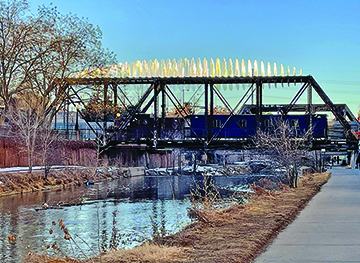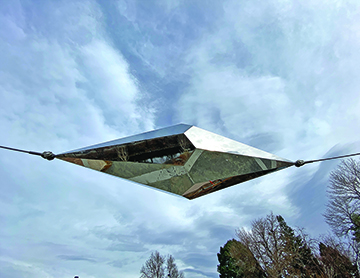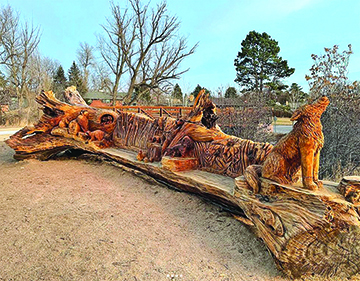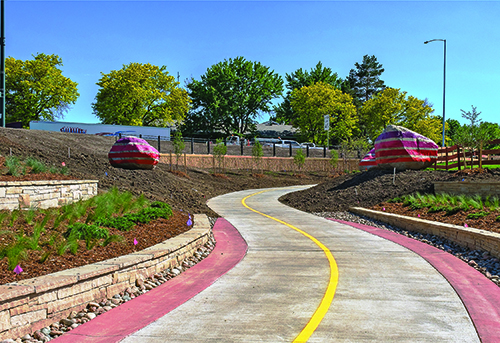
by Jessica Hughes | Apr 21, 2023 | Travel
by Jessica Hughes

 We’re not throwing shade your way, but it is that time of year when Coloradans love their patio time, taking in the sunsets, and cool summer evenings. But we all know that the sun is intense at our elevation. That’s where a good set of shades, not just for your eyes, but for your home as well, is a good investment.
We’re not throwing shade your way, but it is that time of year when Coloradans love their patio time, taking in the sunsets, and cool summer evenings. But we all know that the sun is intense at our elevation. That’s where a good set of shades, not just for your eyes, but for your home as well, is a good investment.
Family owned and operated for several generations, Cherry Creek Shade & Drapery (CCSD) opened in 1968 by Kelcy Kershner’s grandmother. Then bought by her parents, the company has continued to operate as one of the top window treatment professionals along Colorado’s Front Range ever since. Kershner, an interior design consultant for the company, has been running the business with her dad, Doug Kershner, and her sister, Ashley Kershner, and loves the level of service their company is able to provide its clients.
Aside from their well-run family business, CCSD prides themselves on catering to their client’s personal style and needs. As opposed to big box stores where you might not get the personal attention you require, they provide an additional level of service and consideration. “We visit your home and work to cater to your personal style,” says Kelcy. “We offer suggestions and guide our clients through the process — treating it almost like an artform.”
Design, install, and repair. CCSD does it all. Their free in-home consultations are the ideal way to start your journey in picking out your interior or exterior window treat ments with a m
ments with a m aster installer alongside of you during the entire process. “Working with a personal designer that can offer recommendations and professional input, is helpful when it comes to making those hard decisions,” says Kelcy. “Not having to do all this on your own is an important component to this investment.”
aster installer alongside of you during the entire process. “Working with a personal designer that can offer recommendations and professional input, is helpful when it comes to making those hard decisions,” says Kelcy. “Not having to do all this on your own is an important component to this investment.”
Their in-house installers are professionally trained and come with years of experience. In fact, Ashley Kershner was named the first female master installer in the state of Colorado in 2012. “Our designers work to hand select almost everything for you including draperies, soft goods, custom pillows, exterior roller shades, and any kind of window covering, etc.,” says Kelcy. “We match our recommendations to your personal style and preferences.”
Plus, CCSD has spent years creating the largest inventory of products from some of the top name brands for window treatment and fabric manufacturers in the industry. Clients can shop their large showroom of products and fabrics, with over 100,000 fabrics to choose from, making it easier for your home to fit your personal style and taste. And with their variety of products to select from, it makes sticking to budget an achievable goal. And for the eco-conscious, a lot of their products focus on energy efficiencies such as using skylight coverings, cellular shades, thermal lining to draperies, and more.
So, stay cool this summer with custom window treatments that reflect your style and budget with Cherry Creek Shade & Drapery. Cherry Creek Shade & Drapery is located at 2438 E Sixth Ave in Denver. Visit www.cherrycreekshadesanddraperys.com for more information.

by Jessica Hughes | Apr 21, 2023 | General Featured
by Jessica Hughes

Cycle instructor, Allissa Benson, wins ClassPass’ Best Instructor 2022 Award.

Instructor Allissa Benson leads her students through a 45-minute energetic workout.
Local Denver indoor-cycling studio, High Ride Cycle, pedals its way to two national Best of ClassPass awards as the fitness craze of indoor cycling makes its way to the Mile High City.
ClassPass, a monthly membership platform providing access to thousands of studios, gyms, spas, and salons, recently announced their Best of ClassPass Awards and High Ride Cycle was among the winners. Despite such a competitive fitness market, High Ride Cycle beat out studios across the country with cities like L.A. and NYC that dominate this sector of the fitness world.
The “Best of” Awards recognize and honor the top five nominations across multiple categories including Best Wellness Business, Best Fitness Studio, and Best Instructor. This year, Denver’s High Ride Cycle is the only studio to bring home two awards: Best Fitness Studio and Best Instructor.
“It is incredible that we were selected among thousands of studios, and I am humbled to receive best instructor in the nation.,” says Allissa Benson, winner of ClassPass’ Best Instructor 2022 Award and VP of Marketing at High Ride Cycle. “It feels great to be recognized on this level.”
Known by the community for her tenacity, contagious passion, and enthusiasm, Benson’s 45-minute class is often waitlisted and defined by riders as an inspiring and intense experience.
“Winning this award means the world to me,” said Benson. “I pour my life and soul into what I do, and it validates my sense of purpose, affirms that I’m in the right place, at the right time. It is breathtaking to know that the people that inspire me every single day, are also inspired by me.”
Classes at High Ride Cycle are rhythm-based cardio incorporating weights and resistance for a full-body workout. The fitness experience combines choreography, music, lights, and a whole lot of personality for a 45-minute workout that is approachable for all levels. “It’s like a dance

High Ride Cycle wins ClassPass’ Best Fitness Studio Award 2022.
party on a bike,” says Benson. “The room is dark with a wild lighting system and loud music. It’s so immersive you forget how hard you are working.”
But Benson explains that what sets them apart from other cycle studios is their community. “There is a welcoming energy as soon as you arrive at the studio,” says Benson. The studio also doesn’t talk numbers. There is no scoreboard keeping track of calories or heartrate, which Benson also says separates them from other cycle studios.
“We don’t talk about output or measurement. There is no leader board,” says Benson. “This creates an environment that makes everyone feel welcome.”
For newcomers, don’t be intimidated. Benson says a lot of what they teach in every class is for first timers. “We make our new riders feel welcomed and supported,” says Benson. “We are constantly focused on the newcomers and creating the best experience for them.”
She also explains it takes about three to five classes to get into the groove. And says their new rider special supports that with five classes for $25. “That’s how long it takes to get used to our lingo.”
When High Ride Cycle opened its first location in Sloan’s Lake, founders Megan and Scott Hanson committed themselves to teaching a one class format with hopes of being well received. Today, the Hanson’s have surpassed their expectations with 5 “Best of ClassPass” awards under their belt, two thriving studio locations, nearly 30 energetic instructors, and plans to open a third location in Denver University’s neighborhood this spring.
For more information about High Ride Cycle, please visit highridecycle.com.
High Ride Cycle Locations:
High Ride Cycle, Sloan’s Lake
1711 Sheridan Boulevard A
Edgewater, CO 80214
High Ride Cycle, Northglenn
2145 E. 120th Ave. H
Northglenn, CO 80233
High Ride Cycle, University
(coming soon)
1316 E. Evans Ave. 150
Denver, CO 80210
Photos provided by High Ride Cycle

by Jessica Hughes | Mar 21, 2023 | Main Articles
by Jessica Hughes


The Glendale rugby team, American Raptors, has returned to the U.S. to continue its season at Infinity Park Stadium in Glendale.
When the Colorado Raptors withdrew from Major League Rugby back in April 2020, the direction of the team was unknown. Now, as of fall 2021, the Raptors brand returned after the club announced the decision to transition from the Colorado XOs to the American Raptors.
The American Raptors is a team of cross-over athletes from all different athletic backgrounds learning to play the sport of rugby. The intention for creating this team is to help build out a talent pool of American rugby players that can eventually be recruited to play American rugby in the U.S.A. Rugby World Cup.
But not just anyone can join. General Manager Peter Pasque runs a sort of boots-on-the-ground campaign recruiting a pipeline of non-traditional rugby players from across the nation. The invite-only roster has seen some success stories with athletes such as David Still, who played college football and joined the Colorado XOs team for eight months and will now play in the 2024 Olympic rugby team.
This will be the first season the American Raptors will play in the Super Rugby Americas League, which officially launched in 2019 as SLAR. The competition is made up of seven franchises focused on the development of rugby players. The league is made entirely of teams from South America, with the American Raptors as the only team from North America. Other firsts to join this year in the competition include two franchises from Argentina, and one each from Brazil, Chile, Paraguay, and Uruguay. Colombian players will also participate in the continental tournament.
The league competition began February 18, 2023, and will conclude June 9. The Raptors split their time between playing in South America — where they have been the last two months — and at Glendale’s Infinity Park.
Their home opener concluded March 24 against Dogos, with five more home matches lined up, before ending the season in South America. If they advance, the post-season will take pla ce the first two weeks of June with the final match played in Uraguay.
ce the first two weeks of June with the final match played in Uraguay.
Infinity Park is a fun venue to enjoy the fast-paced game of rugby. Come out and see some big hits, meet the players, and support the Raptors. Tickets are $10 and children 12 and under are free.
For more about the American Raptors visit them at americanraptors.com or on social media, @Ameri canRaptors. Games are broadcast on ESPN+.
Photos by Sebastian Miranda of Gaspafotos

by Jessica Hughes | Feb 22, 2023 | General Featured
by Jessica Hughes

Virga by Patrick Marold. Photo by Rudi Cerri

Infinite Span by Michael Buckley. Photo provided by denverpublicart.org
With more than 400 pieces in the Denver Public Art Collection and more than $40 million funding into new public art commissions, the City and County of Denver is dedicated to its public art program.
The collection includes traditional art forms such as sculpture and painting, but also includes sound art, projection and light-based works, interactive new media pieces, temporary fiber-based works, and performance-based works.
The program was established in 1988 as an Executive Order under Mayor Federico Peña. The order states that 1% of any capital improvement project over $1 million undertaken by the City, be set aside for public art. Additional funding comes from the Urban Arts Fund, a graffiti prevention and youth development program, focusing on community-building and social change.
Over the past 30 years these commissioned artworks, along with historic and donated works, make up Denver’s Public Art Collection.
As we spring forward into war

Cottonwood Critters by Chainsaw Mama. Photo by JLH in DESIGN
mer days, it’s a great time to discover some of Denver’s public art that can be found along its most popular trails. So, hit the trail and immerse yourself in nature and the arts with these notable stops.
Cherry Creek Trail
From Confluence Park to Cherry Creek Reservoir, use the Cherry Creek Trail Tour to find these and other artful stops along the 11 mile stretch of Cherry Creek in Denver.
A favorite piece along the trail is the Virga by artist Patrick Marold. The piece sits atop the Delgany St. Bridge over the trail. Made of over 300 stainless steel tubes, suspended in the structural steel, the architectural sculpture was inspired by the cycle of water in Colorado and is intended to eventually support the growing vines on the west end of the bridge. Blending art with nature, the installation may become a living canopy over the bridge.
Located at Confluence Park at Shoemaker Plaza, Sing and Glide by artist Jeanne Quinn, is a mosaic sculpture using the colors of the sea to mimic the flow of the river that cuts through the urban park. “Confluence Park brings together two rivers, the South Platte and Cherry Creek. It is also an urban park, a place where nature and city life are married,” the artist, Jeanne Quinn said in a statement about her work.

We Are Future Strata by Michael Buckley. Photo provided by High Line Canal Conservancy
Created by artist John King, Talk to the Birds, is a 16’ mild steel kinetic sculpture. Located in the Hampden neighborhood, the artwork is installed in a grassy section formed by the junction of the Cherry Creek Trail and the spur trails from South Havana Street. The goal of this artwork is to celebrate the community, uniqueness, and diversity of the students at the Joe Shoemaker School.
High Line Canal
From Waterton Canyon to Green Valley Ranch, just south of Denver International Airport, the High Line Canal runs 71 miles long, divided into two main areas — the northern and southern half. “In general, the northern half of the canal trail is paved and it’s where people will find more public art pieces,” says Suzanna Fry Jones, Senior Director of Programs and Partnerships at the High Line Canal Conservancy.
“A focus for us is to see how we can enhance the trail but not interfere with the natural scenery around it,” says Jones. A perfect example of that is the artwork found at the corner of Hampden and Colorado (mile 37). Titled, We Are Future Strata, the cluster of three 50,000-pound granite boulders are painted with brightly colored stripes meant to depict strata. Local artist, Michael Buckley, wanted to convey a post-human future where the man-made environment has become strata stone.
The art found along the trail system is a mix of commissioned pieces by the Denver Public Art program and community artists adding to public spaces. “In fact, much of the art pieces found along the trail happened organically from the locals in the community,” says Jones.
Some of these pieces include Ceramic Birds, artist unknown, located in Centennial near mile 29. Other pieces include unique wood carvings by Loveland artist known as Chainsaw Mama. There are two at Bible Park, near mile 41 and 42, plus the third sculpture, Cottonwood Critters, a bench near I-25 and mile 39.
To learn more about the High Line Canal Trail and what to see use their online guidebook.
South Platte River Trail
With the improvements made over the years along the South Platte River Trail, public art has been added in a few spots to help with its beautification. One piece of note is Infinite Span, by artist Michael Buckley.
Located at the Grant-Frontier Park, in the Overland neighborhood, the piece is a mirror-polished stainless-steel diamond suspended by stainless steel cables. Floating over Grant Frontier Park, the artwork is meant to represent the infinite nature of time and the fleeting present moment.
To build your own Denver Public Art Tour visit them at DenverPublicArt.org or use one of theirs highlighting certain areas and themes. They also host guided tours with the summer schedule coming out soon.

by Jessica Hughes | Dec 16, 2022 | Main Articles
by Jessica Hughes
As we all look to the new year with fresh intentions and a goal-oriented mindset, one new year resolution that has become popular over the years is Dry January. A health campaign that started in 2013, Dry January is a way to begin the new year with healthy habits and a clear mind by removing alcohol consumption for the entire month.
Whether you need a break from drinking after the holidays, kick-start a healthier routine, or have always preferred not to drink, achieve your goals without feeling deprived, with curated mocktail menus from these local Denver bars.
Honey Elixir Bar

Non-alcoholic potions that tend to the body and mind, from Honey Elixir Bar. Photo courtesy of Honey Elixir Bar Facebook
Where: 2636 Walnut St. #104, Denver, CO 80205
Encouraging rejuvenation over depletion, Honey Elixir Bar is a drinking experience that is meant to reinvigorate and stimulate, not tear down. Their chic mocktails and cocktails are met with equally chic interiors of their funky lux lounge where sipping has become a lost art form. You won’t find any imitations of well-known cocktails, as their mocktail menu is truly original with favorites like the Chocolit and the Mai Chai.
The cornerstone of their elixir bar is the fermented drink, Jun. Similar to kombucha, Jun uses honey and green tea instead of black tea and cane sugar. Honey has partnered with two local master brewers of Jun, Ish’s Brew and Ling Elixirs (both based in Boulder) to offer this healthy alternative as the basis for many of their mocktails. Do note, Jun does naturally contain 3-4% alcohol.
For truly non-alcoholic drinks, sip and savor their natural cacao or shift your consciousness with invigorating drink potions infused with botanicals, herbs, and super foods. Even their cocktails are made with high-quality spirits, honey instead of sugar, and high-quality botanicals, so no need to feel guilty with these alcoholic drinks.

An artful cocktail bar paired with crafty mocktails at Room for Milly. Photo courtesy of Room for Milly Facebook
Room For Milly
Where: 1615 Platte St., Suite 145, Denver, CO 80202
With a nod to travel and an ultra-modern-chic atmosphere, Room for Milly is designed to be a place for friends to gather over a good conversation, admire an artful interior, and enjoy a good cocktail. Along with their beer, wine, and sake menu, the bar also features a tantalizing list of zero-proof beverages. The select group of three include: the Cantab, a jasmine iced tea with umb shrub and pomegranate; the Clara with seedlip spice, tonic; and the Avenue No. 3 with seedlip spice, ginger, jasmine tea, honey, and citrus.
Forget me Not
Where: 227 Clayton St., Denver, CO 80206
Located in the heart of Cherry Creek, Forget Me Not is a cocktail bar that infuses the art of decor, sophistication, and color in both its drinks and its interiors. Placed in the middle of their large cocktail menu are three delightful zero-proof drinks that won’t make you miss the liquor. Choose from the Perfect Vision with seedlip grove, coconut water, verjus, rose water; the Deep Roots with seedlip garden, tarragon, beet, ginger, citrus stappi red bitter; and the Green Machine with seedlip grove, cucumber, salted lemon, and ginger.
Lady Jane
Where: 2021 W. 32nd Ave., Denver, CO 80211
Located in the trendy LoHi neighborhood, Lady Jane is an unpretentious cocktail bar that makes serving

Forget Me Not’s Green Machine made with seedlip, cucumber, and salted lemon. Photo courtesy of Forget Me Not Facebook
delicious drinks look easy. On their menu, are four mocktails that do anything but mock other cocktails. With four original drinks, including a pomegranate-ginger spritz, a spiced apple sour, coffee colada, and a pink guava cooler. While you will find more cocktails than mocktails on the menu, even their alcoholic drinks serve up fresh local ingredients with high-end spirits to minimize the guilt factor.
Death & Co.
Where: 1280 25th St., Denver, CO 80205
Don’t despair, even the most sought-after cocktail lounge, Death & Co. is home to a surprisingly decent list of mocktails and non-alcoholic drinks. The swanky RiNo location invites cocktail and mocktail purveyors alike, with the carefully curated zero-proof drink selection. Choose from three different options: the Alpenglow with hibiscus, black tea, bay leaf, lime, and seltzer; the Holidays in the Sun with non-alcoholic dry Aperitif, Moroccan mint tea; and Out of Time with Three Spirits Livener, blueberry, cold brew, and coconut. In addition to their mocktails, they also offer a brief selection of non-alcoholic beer and wine.


 We’re not throwing shade your way, but it is that time of year when Coloradans love their patio time, taking in the sunsets, and cool summer evenings. But we all know that the sun is intense at our elevation. That’s where a good set of shades, not just for your eyes, but for your home as well, is a good investment.
We’re not throwing shade your way, but it is that time of year when Coloradans love their patio time, taking in the sunsets, and cool summer evenings. But we all know that the sun is intense at our elevation. That’s where a good set of shades, not just for your eyes, but for your home as well, is a good investment. ments with a m
ments with a m aster installer alongside of you during the entire process. “Working with a personal designer that can offer recommendations and professional input, is helpful when it comes to making those hard decisions,” says Kelcy. “Not having to do all this on your own is an important component to this investment.”
aster installer alongside of you during the entire process. “Working with a personal designer that can offer recommendations and professional input, is helpful when it comes to making those hard decisions,” says Kelcy. “Not having to do all this on your own is an important component to this investment.”












